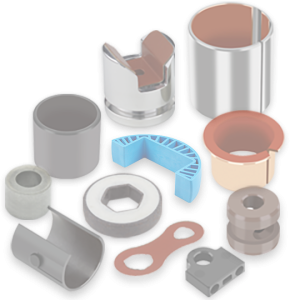From a bearing design point of view, the most important dimension is the Installed ID. This is because the Installed ID controls the amount of shaft clearance and therefore the accuracy of the bearing/shaft assembly. For a given shaft diameter, if the Installed ID is too large there may be excessive shaft clearance which could result in excessive misalignment, wobble, excessive gear wear in gear trains, inability to develop a hydrodynamic film in lubricated applications, etc. If the Installed ID is too small there may be potential seizure due to frictional heat; insufficient lubrication flow to and/or through the bearing, etc.
After a sleeve bearing is pressed into its housing bore the resulting Installed ID is a function of three factors: the Housing Bore ID and the Free State OD and Free State ID of the sleeve bearing. By knowing the specific tolerances of the housing bore and sleeve bearing you can determine the range of Installed ID:
Min Installed ID = Min Bearing ID – (Max Bearing OD – Min Housing Bore)
Max Installed ID = Max Bearing ID – (Min Bearing OD – Max Housing Bore)
The above formulae are used when the sleeve bearing does not have a split (such as: GGB Fiber Reinforced Composite Bearings GAR-FIL®, GAR-MAX®, HPF®, EP® products). Sleeve bearings that do have a split (such as GGB Metal-Polymer products, DU®, DP4®, DX®, HI-EX®) are known as “wrapped” bearings or bushings.
However, the ID and OD of a wrapped bearing cannot be accurately measured because those bearings are not perfectly cylindrical and the split which is slightly open in the free state. Instead, the bearing diameters are indirectly specified by using GO and NOGO ring gages per ISO 3547 Part 2, Test B (or, alternatively, the centerline checking method per ISO 3547 Part 2, Test A) for the OD and then using the wall thickness tolerance per ISO 3547 Part 2, alternative Test C. In the case of a wrapped bearing you can determine the range of Installed ID by using the specified housing bore and wall thickness ranges:
Min Installed ID = Min Housing Bore – 2 x (Max Wall Thickness)
Max Installed ID = Max Housing Bore – 2 x (Min Wall Thickness)
What is meant by Free State ID
As noted before, the Free State ID can only be measured in sleeve bearings that do not have a split. The Free State ID is larger than the Installed ID to compensate for the interference fit between the Free State Bearing OD and the Housing Bore.
The Free State ID cannot be defined for wrapped sleeve bearings because the bearing is not perfectly cylindrical and the split is slightly open in the free state. The diameters of wrapped sleeve bearings are specified in ISO 3547-2 which is explained in the GGB DU®/DU-B Handbook.





